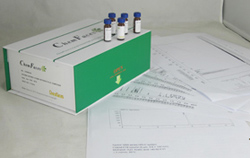Hot Products



| Catalog No. | Information |
| CFN98757 | Afzelin Afzelin has several cellular activities such as DNA-protective, antibacterial, antioxidant, and anti-inflammatory as well as UV-absorbing activity and may protect human skin from UVB-induced damage by a combination of UV-absorbing and cellular activities. Afzelin has potenial anti-cancer activity against prostate cancer, the activity is due to inhibition of LIM domain kinase 021 expression, it can inhibit the proliferation of LNCaP and PC302cells, and block the cell cycle in the G002phase. Afzelin can attenuate asthma phenotypes is based on reduction of Th2 cytokine via inhibition of GATA-binding protein 3 transcription factor, which is the master regulator of Th2 cytokine differentiation and production. |
| CFN90875 | Agarotetrol Agarotetrol is a chromone derivative isolated from Agarwood. |
| CFN99203 | Agnuside Agnuside has anti-arthritic activity, it also shows inhibition of vascular permeability and leukocyte migration in vivo.It inhibited an array of pro-inflammatory mediators (PGE(2) and LTB(4)) and T-cell-mediated cytokines (IL-2, TNF-α, IFN-γ, IL-4, IL-10, IL-17). |
| CFN98169 | Agrimol B Agrimol B has antibacterial activity against Pseudomonas syringae pv. lacrymans (bacterial leaf spot pathogen), Ralstonia solanacearum (tomato bacterial wilt pathogen) and Pseudomonas syringae pv. tabaci (Tobacco wild fire pathogen). Agrimol B has a therapeutic potential on alleviating obesity, through modulation of SIRT1-PPARγ signal pathway. |
| CFN98073 | Agrimonolide Agrimonolide is a potential α1 adrenergic receptor antagonist, it exerts anti-inflammatory activity, at least in part, via suppressing LPS-induced activation of JAK-STATs and p38 MAPKs signaling pathway. Agrimonolide and desmethylagrimonolide can effectively increase insulin-mediated glycogen level in heptocytes, they may play an important role in regulating glucose metabolism in insulin-resistance HepG2 cells and could be developed as a promising natural material for diabetes prevention and treatment. |
| CFN99374 | Agrimonolide 6-O-glucoside Agrimonolide-6-O-glucopyranoside has antimicrobial activity. |
| CFN97561 | Ailanthone Ailanthone has anti-inflammatory, anti-HIV, anti-malarial, anti-allergic, antiulcer and antimicrobial activities; it also has potent antineoplastic activity against hepatocellular carcinoma (HCC), it can inhibit huh7 cancer cell growth via cell cycle arrest and apoptosis in vitro and in vivo. Ailanthone has significant pre-emergence herbicide activity , is directly correlated to Ailanthone concentration. |
| CFN98761 | Ajmalicine Ajmalicine, also known as δ-yohimbine or raubasine, is an antihypertensive drug used in the treatment of high blood pressure. |
| CFN93513 | Ajmaline Ajmaline is a class Ia anti-arrhythmic compound that is widely used for the diagnosis of Brugada syndrome and the acute treatment of atrial or ventricular tachycardia. Ajmaline inhibits cardiac Kv1.5 and Kv4.3 channels at therapeutic concentrations. |
| CFN92752 | Ajugacumbin A Reference standards. |